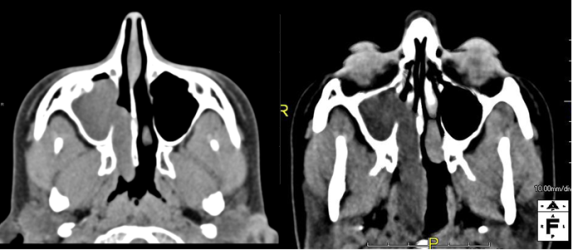Antrochoanal Polyp
A 22-year-old female with a history of right sided nasal obstruction, cheek pain and new onset of snoring. Patient was initially treated conservatively with oral antibiotics, and symptomatic medical management, but had minimal improvement and eventually progression of symptoms.
Clinical History: A 22-year-old female with a history of right sided nasal obstruction, cheek pain and new onset of snoring. Patient was initially treated conservatively with oral antibiotics, and symptomatic medical management, but had minimal improvement and eventually progression of symptoms.

Figure 1: Scout view demonstrates a soft tissue mass extending from the region of the paranasal sinuses into the nasopharynx with tip of mass just below the uvula (arrow).

Figure 2: Axial CT (a) and axial oblique reconstruction (b) demonstrate a hypo-attenuating mass filling the right maxillary sinus with extension into the nasal cavity. On the reconstructed image the lesion is seen extending further into the nasopharynx.

Figure 3: Coronal reconstruction (a) demonstrates that this lesion extends through and widens the associated osteomeatal unit (arrow). Sagittal oblique (b) reconstruction demonstrates extent of this lesion from the maxillary sinus, through the nasal passage and into the nasopharynx.
CT Sinus:
Non contrast CT demonstrates complete opacification of the right maxillary sinus, extending into the nasal passage, nasopharynx, and downward into the oropharynx, just beyond the inferior tip of the uvula. Findings are most consistent with an antrochoanal polyp.
Follow-up:
Clinical evaluation by an ENT physician confirmed the findings. Surgical resection was performed, with pathology confirming the diagnosis of antrochoanal polyp. At surgical excision the lesion was noted to measure 5 cm long by 1.5 cm in diameter.
Discussion:
Epidemiology/Pathology: Antrochoanal polyp (ACP) was first described in 1909 by Gustav Killian (they are sometimes referred to as Killian polyps); however, the original description of nasal polyps extends back to 1691 by Fredrik Ruysch. ACP is a benign polypoid lesion that arises in the maxillary sinus and extends through the antrum into the nasal cavity. These can occur in other sinuses and spread to the nasal passage, but are named by the involved structures (ex. sphenochoanal polyp). ACP is the most common type.
The majority occur in patients with underlying sinus disease and/or allergies (65 percent to 83 percent depending on study). Pathologically these lesions are inflammatory in nature, and contain cystic and solid components. The vast majority of cases are unilateral without predilection for a particular side; however, bilateral polyps do occur. They can present in patients of any age, but more common in the 20s to 40s.
Symptoms: Symptoms are similar to findings of sinus disease: pain, pressure, drainage, headache, breathing disturbances. Additionally, ACP may result in obstructive nasal symptoms. For example, our patient demonstrated new onset of snoring.
Radiographic findings:CT findings demonstrate a well defined, hypo-attenuating lesion opacifying the involved sinus, with extension through the antrum into the nasal passage. Lesions are often dumbbell shaped due to narrowing at the antrum between the sinus and the nasal cavity. Peripheral enhancement of the nasal passage/sinus may be present, but there should be no central enhancement. Increased central density, suggests chronicity and/or fungal etiology.
Differential Diagnosis:
• Inverted papilloma
o Begins in the nasal passage and extends into the sinus
o Can be difficult to determine, if extensive, where the lesion begins in order to distinguish inverted papilloma from ACP.
• Mucocele/Retention cyst
o Neither expand into choana typically
• Angiofibroma
o Vascular – enhances avidly
• Other tumor (ex. Esthesioneuroblastoma)
o Differentiated by enhancement pattern, as ACP should have no central enhancement.
o If only a post contrast CT is performed, remember that chronic/fungal ACP can have central high density, which would be visible on a non-contrast study.
Treatment: Surgical referral and resection. Previously polypectomy and Caldwell-luc procdure. More commonly done by Functional endoscopic sinus surgery (FESS). ACP do not resolve with conservative management.
References:
1. Frosni, et al. Antrochoanal Polyp: Analysis of 200 Cases. Acta otorhinolaryngologica italica.2009:29:21-26.
2. Lee, Jae Yong. Unilateral Paranasal Sinus Diseases: Analysis of the Clinical Characteristics, Diagnosis, Pathology, and Computed Tomogrpahy Findings. Acta Oto-laryngologica. 2008; 28(6):621-625.
3. Nair, et al. A Review of the Clinicopathological and Radiological Features of Unilateral Nasal Mass. Indian Journal of otolaryngology and Head and Neck Surgery. 2011; 1-6.
4. Yeman et al. Evaluation and Management of Antrochoanal Polyps. Clinical and Expeerimental Otorhinolaryngology. 2010; 3(2): 110-114.
Nicholas B. Caruana, M.D. and Erini Makariou, MDMedStar Georgetown University Hospital, Department of Radiology
GE HealthCare Debuts AI-Powered Cardiac CT Device at ACC Conference
April 1st 2025Featuring enhanced low-dose image quality with motion-free images, the Revolution Vibe CT system reportedly facilitates improved diagnostic clarity for patients with conditions ranging from in-stent restenosis to atrial fibrillation.
The Reading Room Podcast: Current Perspectives on the Updated Appropriate Use Criteria for Brain PET
March 18th 2025In a new podcast, Satoshi Minoshima, M.D., Ph.D., and James Williams, Ph.D., share their insights on the recently updated appropriate use criteria for amyloid PET and tau PET in patients with mild cognitive impairment.